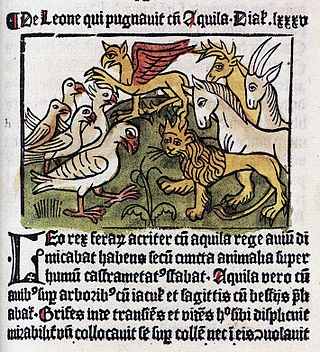
Polish literature is the literary tradition of Poland. Most Polish literature has been written in the Polish language, though other languages used in Poland over the centuries have also contributed to Polish literary traditions, including Latin, Yiddish, Lithuanian, Russian, German and Esperanto. According to Czesław Miłosz, for centuries Polish literature focused more on drama and poetic self-expression than on fiction. The reasons were manifold but mostly rested on the historical circumstances of the nation. Polish writers typically have had a more profound range of choices to motivate them to write, including past cataclysms of extraordinary violence that swept Poland, but also, Poland's collective incongruities demanding an adequate reaction from the writing communities of any given period.
The Dialogus de Scaccario, or Dialogue concerning the Exchequer, is a mediaeval treatise on the practice of the English Exchequer written in the late 12th century by Richard FitzNeal. The treatise, written in Latin, and known from four manuscripts from the 13th century is set up as a series of questions and answers, covering the jurisdiction, constitution and practice of the Exchequer. One academic said that "The value of this essay for early English history cannot be over-estimated; in every direction it throws light upon the existing state of affairs." It has been repeatedly republished and translated, most recently in 2007.

Ze is a letter of the Cyrillic script.

Bogurodzica, in English known as the Mother of God, is a medieval Christian hymn composed sometime between the 10th and 13th centuries in Poland. It is believed to be the oldest religious hymn or patriotic anthem in the Polish language, which was traditionally sung in Old Polish with the Greek phrase Kyrie eleison – "Lord, have mercy". While its origin is not entirely clear, several scholars agree that Saint Adalbert of Prague is the likely author. Polish knights chanted Bogurodzica prior to their engagement at the Battle of Grunwald and it also accompanied the coronation ceremonies of the first Jagiellonian kings.

The Brześć Kujawski Voivodeship was a unit of administrative division and local government in the Kingdom of Poland, from the 14th century to the Second Partition of Poland in 1793. It was part of the historic Kuyavia region and the Greater Poland Province. Originally, its name was Brzesc Voivodeship, but after the 1569 Union of Lublin, it was renamed into Brześć Kujawski Voivodeship, to distinguish it from Lithuanian Brest Litovsk Voivodeship.

Łukasz de Bnin Opaliński was a Polish nobleman, poet, political activist and one of the most important Polish political writers of the 17th century.

Klemens Janicki (1516–1543) was one of the most outstanding Latin poets of the 16th century.

Mikołaj Hussowczyk. Other name spelling variants include Hussoviensis, Hussovianus, Ussovius, Hussowski, Gusowski); was an early Renaissance poet and humanist of Poland and the Grand Duchy of Lithuania, and a cultural and social activist. His most notable work is the poem Carmen de statura...bisontis.
The Old Polish language was a period in the history of the Polish language between the 10th and the 16th centuries. It was followed by the Middle Polish language.

Chronica seu originale regum et principum Poloniae, short name Chronica Polonorum, is a Latin history of Poland written by Wincenty Kadłubek between 1190 and 1208 CE. The work was probably commissioned by Casimir II of Poland. Consisting of four books, it describes Polish history.
Nicholas Magni was a late medieval theologian, a professor at Prague University and Heidelberg University.

Dialogus creaturarum, is a collection of 122 Latin-language fables and, as the title implies, dialogues of creatures.

The Roman Catholic Diocese of Chełm(-Lublin) was a Latin Catholic bishopric in southeastern Poland, from 1257 until its suppression in 1805, which was restored as Latin titular see in 2009.

The Diocese of Włocławek is a Latin Church ecclesiastical territory or diocese of the Catholic Church in Poland. It is a suffragan in the ecclesiastical province of the Metropolitan Archdiocese of Gniezno. Until the 20th century, it was known as the Diocese of Kujawy.
Augustinus Rotundus was a Christian and Renaissance humanist, erudite, jurist, political writer, first historian and apologist of Lithuania. Rotundus was vogt of Vilnius, general secretary to the Grand Duke and King Sigismund Augustus and elder of Stakliškės. After his nobilitation to the szlachta, Rotundus adopted surname Mieleski, or Milewski.

The history of printing in Poland began in the late 15th century, when following the creation of the Gutenberg Bible in 1455, printers from Western Europe spread the new craft abroad.

The earliest Bible translations into Polish date to the 13th century. The first full ones were completed in the 16th.

The Bible of Queen Sophia is the oldest surviving translation of the Old Testament into the Polish language and the first complete translation of the Bible into Polish. The work is seen as a significant milestone in the history of the Polish language, and the most extensive example of the medieval Old Polish language.
Bogusław Sochnacki was a Polish actor. He appeared in more than 100 films and television shows between 1950 and 2003.

Janina Pohl-Mizerska - Polish cryptographer, nurse, medic in the Warsaw Uprising.















